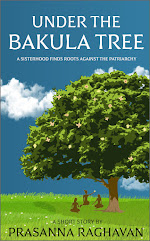The Showing Narrative of Kamba Ramayana
"Bleached bones lay where animals had perished, including those of monstrous serpents with jaws open deadly thirst; into these enormous jaws had rushed (says the poet) elephants desperately seeking shade, all dead and fossilized, the serpents and the elephants alike." |
| Photo by Errin Casano from Pexels |
In an earlier post, Showing Versus Telling about “showing versus telling’ a narrative style in creative writing. I wrote there; I was a practitioner and admirer of telling before taking a creative writing course because that was easy, and I hadn't known about showing. Also, I concluded that showing is a modern narrative style discovered by contemporary creative writers.
My curiosity took me to research the ancient work of the Indian epic, Ramayana, to learn about its narrative style. And the outcome was amazing. I felt rewarded for getting anxious, and I am happy to share my amazement with my readers.
Before I go further, I want to state, I take the epic Ramayana as a magnificent work of Valmiki's creative excellence. There are many versions of Ramayana, Kamba Ramayana. one among them. R.K, Narayanan made a retelling of in 1971. He was a leading author of early Indian literature in English.
My post is based on what I found in R.K Narayan's retelling of Kamba Ramayana in English. In his introduction to this book, he writes that Kamba Ramayana, written in the 11th century CE, is a retelling of the Valmiki Ramayana in Tamil, a South Indian language. “Of his task in assimilating Valmiki and re-interpreting him in Tamil verse, Kamban says, “I’m verily like the cat sitting on the edge of an ocean of milk, hoping to lap it all up.” This shows Kamban’s is a true retelling of the Valmiki Ramayana.
My interest here is the narrative style of Kamba.
In the opening scene of Ramayana, Visvamitra goes to king Dasaratha, Rama's father, to solicit Rama’s help to create a cosy atmosphere for the seers to carry out the rituals through eradicating the asura who had been obstructing the rituals. Dasaratha agrees with reluctance. Raman and Lakshmana follow Visvamitra to the forest.
See how Kamba narrates this part:
“Following the footsteps of their master like his shadows, Rama and Lakshmana went past the limits of the city and reached the Sarayu river, which bounded the capital on the north. When night fell, they rested at a wooded grove and at dawn crossed the river. When the sun came over the mountain peak, they reached a pleasant grove over which hung, like a canopy, fragrant smoke from numerous sacrificial fires………………….”
“……….Visvamitra resumed his journey at dawn and reached a dessert region at midday. The mere expression ‘desert’ hardly conveys the absolute aridity of this land. Under a relentless sun, all vegetation had dried and turned to dust, stone and rock crumbled into powdery sand, which lay in vast dunes, stretching away to the horizon. Here every inch was scorched and hot beyond imagination. The ground was cracked and split, exposing enormous fissures everywhere. The distinction between dawn, noon and evening did not exist here, as the sun seemed to stay overhead and burn the earth without moving. Bleached bones lay where animals had perished, including those of monstrous serpents with jaws open deadly thirst; into these enormous jaws had rushed (says the poet) elephants desperately seeking shade, all dead and fossilized, the serpents and the elephants alike. Heat haze rose and sang the very heavens. While traversing this ground, Visvamitra noticed the bewilderment and the distress on the faces of the young men and transmitted to them mentally two mantras (called “Bala’ and ‘Adi-Bala’). When they meditated on and recited these incantations, the arid atmosphere was transformed for the rest of their passage, and they felt as if they were wading through a cool stream with a Southern Summer breeze.”
I got goosebumps reading this. See the details of the story settings, the aridity, and the ferocity of the desert region.
Read about the medieval poet Kamban here.
Are you amazed at reading this? Please share your thoughts here.
This Post 8 is part of the Blogchatter Half Marathon






6 comments
Creating an atmosphere around the characters and story that is to be unfolded in due course of time, makes a huge difference in engagement of the reader, isnt it!
ReplyDeleteThanks for sharing this graphic narration.
Hundred percent agrees with you. Thank you for the appreciation. :)
DeleteReading Kamba Ramayanam has always been a delightful experience. While Valmiki's Ramayanam appeals to the learned class, Kamba Ramayanam makes it easily approachable and appreciable even to the layman. The poet's eye for beauty is class apart and love his poetic narrations. Even while there are places where Kamabar goes about detailing the scene, he makes a mark at places where he choses brevity with his choice of words, especially when he says "Kandein Seethaiyai" (translating, Met Seetha). Here he chose just 2 words, with making a point to sy "met" first to the Lord Rama who is waiting anxiously. That is where the brilliance of the poet comes out :)
ReplyDeleteThank you for this post :)
Thank you, Seetha, for the appreciation and enhancing my post, adding your intensive study on Kambar. You're adding another point, the power of brevity to his narratives. Reading it, takes me to a different world, to explain its charm has no words. :)
DeleteTotally agree with you...to explain its charm there are no words...the mere feeling of joy brimming while discussing is just wow...thank you for this post :)
DeleteThank you, nice to meet you having same pitch about Kambar :)
DeletePost a Comment